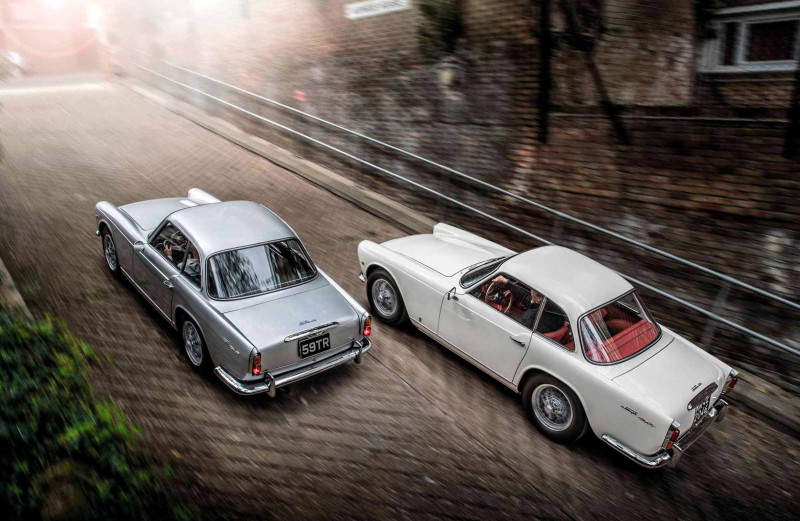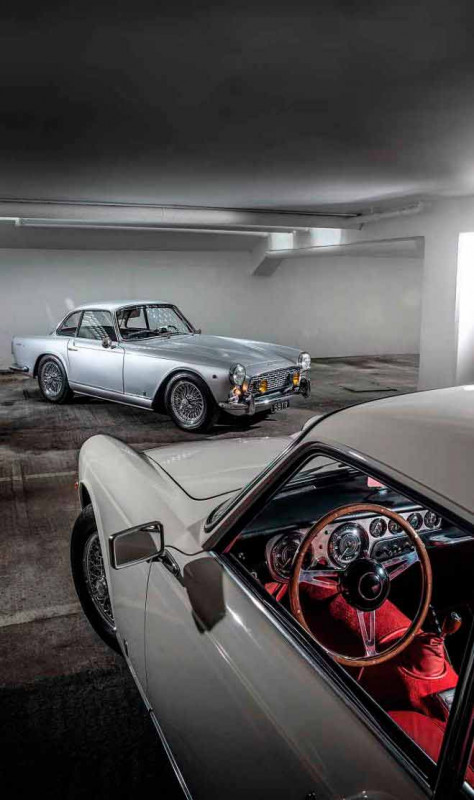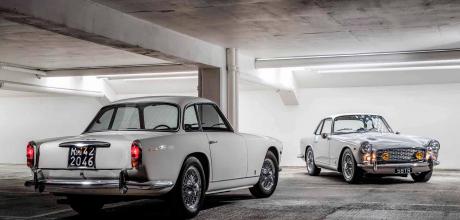1959-1961 Triumph Italia 2000
The prolific Italian stylist Giovanni Michelotti was a mainstay of Triumph design for well over a decade. These special TR3As signal his starting point. Words Richard Heseltine. Photography Charlie Magee.
DOUBLE ESPRESSO Latin take on a traditional British roadster
The backdrop screams 1960s Cold War thriller. An underground garage in the heart of London seems like a venue for the exchange of spies after dark, rather than sun-drenched Jet-Set glamour and the sort of locale where beautiful people would go about their beautiful business in their beautiful Triumph Italia 2000s. None of this matters a jot to the owners of the cars pictured here, mind. No, they’re too busy pointing out the differences between their respective coachbuilt classics.

Lincoln Small and Marc Gordon are near-neighbours in London but, even so, having their cars side by side results in a voyage of discovery. The latter owns the silver Italia, believed to be the eighth car of the 329 purportedly made, and the inner-boot-sited fuel filler is in a different position relative to the other Triumph, car number 95. The rear lights are mounted differently, too, while the beltline on the white car has a less pronounced ‘step’ than its sibling. And… Well, you get the idea.

Their enthusiasm is infectious but, listening in as conversation unspools, two questions nudge to be asked: first, how did two examples of an ultra-rare variant of a popular British sports car, one that was never sold in the UK in period, find their way into the UK? Second, how did they end up with enthusiasts who live barely a stone’s throw from one another? Answers are easy to come by, though deciphering the backstory behind the Italia is rather less so. As is so often the way with these things, the actual and the apocryphal often overlap.
The 1950s saw Italian styling houses reaching for the stars. They were global influencers, with mainstream car manufacturers the world over beating a path to their doors. British marques weren’t slow out of the blocks to tap their creative talents, either, with Giovanni Michelotti being arguably the most in demand. His work with Standard- Triumph in particular is widely celebrated, ‘Micho’ often working in conjunction with his long-time collaborator and foil, Alfredo Vignale.

The TR3 Speciale marked the jumping-off point for their involvement. This one-off confection broke cover at the 1957 Geneva motor show and didn’t bear even trace elements of the donor car stylistically. Instead, Michelotti appeared to derive his inspirations from Detroit: witness the conspicuous tailfins. Those, and an ornate chrome eggcrate grille, gilded bonnet scoop and raked-forward headlight cowls. Inside, there was a new dashboard and black leather trim, complete with leopard skin inserts.
This automotive calling card worked a treat and commissions poured in from Coventry. Michelotti and Vignale’s combined efforts around this time spanned everything from the Triumph Herald to the Standard Vanguard Phase III. However, the Italia 2000, which they co-authored, was something of a cuckoo in the nest in that it was the brainchild of the marque’s Italian distributor, Salvatore Ruffino. This would-be motor mogul acquired the rights to the Standard-Triumph concession in 1957, and the Neapolitan was convinced there was demand for an Italianate version of the bare-bones TR3A.
Ruffino tapped Michelotti, having been unimpressed by a prior proposal from Zagato. This gifted stylist in turn conjured a coupé based on the roadster’s running gear in time for the 1958 Turin motor show, one that was built by Carrozzeria Vignale. It was nothing if not distinctive, with an expansive glasshouse and a ‘droop snoot’ front end, complete with Perspex-shrouded headlights. The prototype was well-received, too, with Road & Track stating: ‘Those who have longed for a better-looking Triumph TR3 had their wish in the car by Michelotti, who is, incidentally, probably the most versatile designer in Italy.’

A second prototype was then displayed on the Carrozzeria Vignale stand at the following year’s Turin motor show. It bore significant styling differences, not least a revised frontal styling treatment that was as bluff as its forerunner’s had been pointed. That, and a loftier roofline. However, it is equally possible that this second car was simply the initial prototype in reconfigured form. Whatever the truth, reaction was positive and this was sufficient incentive for Ruffino to push ahead with his plans for series manufacture. His vision called for 1000 cars to be made each year – but first there was the small matter of securing support from Standard-Triumph.
The home brand variant was evaluated in Coventry, and the firm’s MD Alick Dick gave his blessing. With Carrozzeria Vignale having sufficient capacity to build the car at its Via Cigliano plant in Turin, success seemed a formality despite the price: at around 2,500,000 lire, it was significantly more expensive than a regular TR3A. Production began in December 1959, and the Italia employed an unusual mix of old-school coach-building and modern practices, its steel body having the wings as integral parts of the main bodyshell that, in turn, was then welded to the chassis at its rearmost extremities. It was bolted on elsewhere.
The Italia brochure made much of its mixed heritage. ‘Italian bodywork at its best, British tradition in sports car engineering at its finest,’ it boasted. ‘Ruffino SpA Industria Costruzione Automobili presents the Italia 2000 Coupé, a new Gran Turismo car of international class. Designed by Giovanni Michelotti, one of the world’s leading stylists, and built by Alfredo Vignale, an artist in his line, the Italia 2000 Coupé incorporates the world famous chassis and engine of the Triumph TR3A. From the moment of its appearance on the international scene, the expert, the sports car enthusiast and the general public have acclaimed this brilliant match between incomparability of line and outstanding performance.’

The use of ‘Italia 2000’ rather than the original ‘Triumph Italia’ tag was telling, the only physical reference to the British marque being ‘TM Triumph’ badges on the rear wings. The ‘TM’ part denoted telaio e motore, which translates as ‘chassis and engine’, while Vignale logos were conspicuously smaller than on the prototypes. However, the car’s chances were foiled before it was far out of the starting blocks. Standard-Triumph was taken over by Leyland Motors in 1961, heralding the Italia’s downfall. Ruffino had a verbal rather than a formal agreement for the supply of rolling chassis and support was withdrawn, possibly out of fear that it would provide competition for the new TR4 (another Michelotti design). Not only that, the new keepers objected to the use of ‘Triumph 2000’ in the nomenclature, while Ruffino took legal action in the belief that rolling chassis arriving from Coventry didn’t meet the agreed ‘Italia specification’.
If that wasn’t enough to put a crimp in Ruffino’s karma, he fell out with Vignale over the quality of his work (or lack thereof). It didn’t help that Carrozzeria Vignale moved premises in 1961, and the firm wasn’t above farming out jobs. Attempts to sell the Italia 2000 outside its homeland, meanwhile, were only partially successful. US sales were handled by Stutz Plaisted, a Volvo dealer from Massachusetts (although some were sold via Inter National Motors of Los Angeles). However, there was little by way of support in the supply of non-Triumph parts, so owners were required to sign an indemnity form by way of acknowledgement. Production ended in late 1961, or mid-1962 depending on whose estimates you credit. Around 30 were fashioned on the TR3B chassis six months after the last of the TR3A-based cars had been assembled, and as many as six Italias were built to right-hand-drive configuration. That said, cars were still being offered for sale as late as 1964. Legend has it that an embittered Ruffino destroyed the original Italia drawings and all documentation pertaining to its manufacture.
Arch-enthusiast Lincoln Small first heard about his Triumph in 2012. ‘It belonged to a resident of Monte Carlo, but the car was in Milan,’ he says. ‘For me, the Italia marries beauty with simplicity and that is what fascinated me. It was advertised on eBay as a wreck. I put in a bid but then the price started to climb. I managed to find a phone number for the chap who was selling it and called him. It turned out that it was between me and another bidder. I told him to give me a price and we agreed terms after he sent me something like 300 photos. The car had apparently been owned for most of its life by an Alitalia pilot who parked it in an underground garage and forgot about it for 30 years. Another guy then bought it but he just left it there. I did a deal whereby the car was delivered to my friend Marco Gandino, who runs Classic Mania Garage in Ovada, near Genoa. He spent the next three years restoring it.
‘The car was in a terrible state when I got it, but it was 95% complete, and the TR Register was very helpful,’ he continues. ‘It turned out that the Italia registrar had been the underbidder. I just love looking at it. There are hints of Maserati 3500GT, Lancia Appia; all sorts of things. I cannot get enough of the detailing. The dashboard is exquisite, as are the badges. The rear script alone is fantastic. It’s a work of art. The Italia is a strange car to drive, though. By that, I mean you look at it and expect it to be quite revvy, like a four-cylinder Alfa or a Lancia, but it isn’t. You have this glorified tractor motor, but it’s so torquey. It just pulls and pulls. It’s fantastic.’
For Marc Gordon, similarly an experienced racer of historic cars, owning an Italia wasn’t on his radar until he met Small. ‘I didn’t even know what an Italia was,’ he says, allowing himself a laugh. ‘It started for me after Lincoln bought a couple of Jaguar E-types. I am the London rep for the E-type Club and through that I got to know him. Lincoln invited me to pop round and see his car collection, which is amazing. There, among the Ferraris, Alfa Romeos and so on was his Italia. I was instantly smitten and that led me to contact the Italia registrar. He said that one of the very best Italias was about to go on sale.’
The silver Italia is perhaps the best-known of all of them, and is widely referred to in TR circles as the ‘Tony Ranson car’. Sadly, Ranson lost his battle with cancer before he got to enjoy it, following a lengthy restoration, and the subsequent owner used it only sparingly. ‘I rang him up and he said a dealer had taken some photos and was about to advertise it,’ says Gordon. ‘I asked him how much he wanted for the car and we did a deal there and then. I must admit to having been a bit nervous. I had never bought a car sight-unseen before, but my expectations were exceeded when it arrived.’ That was in May 2016.
‘Like Lincoln, I fell for its shape, but I love so many individual parts,’ he continues. ‘Art is subjective, but I do think of it as being a piece of art. I love the inset yellow spotlights, the crackle-black dashboard; you can spend hours taking in all the details. Mine has many of the original options, too, such as the Nardi steering wheel, the Weber carbs, and the overdrive, all of which make a difference. It will cruise quite happily. Unlike Lincoln’s Italia, mine hasn’t been converted to a rack-and-pinion steering arrangement. It still has a steering box, and I suppose it is perhaps a little bit vague, but, to be honest, I don’t really notice that much. Unless it’s snowing, I don’t need an excuse to drive the Italia. I love it.’
‘THE CAR’S CHANCES WERE FOILED BEFORE IT WAS FAR OUT OF THE STARTING BLOCKS’
All of which is understandable because this most Italian of British sports car greats is more than just an intriguing curio. It marries beauty with the sort of rugged running gear that can be fixed with a hammer. So many cars of this ilk are better in concept than execution, but that isn’t the case here. The real shame is that the Italia didn’t get to beguile a wider audience.
THANKS TO Nigel Case, Classic Car Club London, classiccarclub.co.uk.
‘THIS MOST ITALIAN OF BRITISH SPORTS CAR GREATS IS MORE THAN JUST AN INTRIGUING CURIO’
Above and top Italian style certainly added glamour to the tried and tested Triumph TR formula; elegant interior uses Triumph fittings to great effect. Above and lower right As is often the case with coachbuilt cars, there are subtle differences between these two, owned by Marc Gordon (silver car) and Lincoln Small.
1959-1961 Triumph Italia 2000
- Engine 1991cc OHV four-cylinder, two SU carburettors
- Max Power 100bhp @ 4000rpm
- Max Torque 119lb ft @ 3000rpm
- Transmission Four-speed manual, rear-wheel drive
- Steering Worm and roller
- Suspension
- Front: double wishbones, coil springs, telescopic dampers
- Rear: live axle, semi-elliptic leaf springs, lever-arm dampers
- Brakes Discs front, drums rear
- Weight 977kg
- Top speed c110mph


